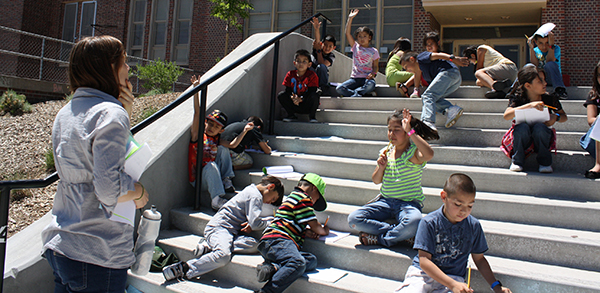Date: 2007
A Rural-Urban Approach to Building Evidence to Prevent Childhood Obesity
Project overview
The two overarching goals of this project are to
- Identify and track key school-level environment and policy features related to healthy eating and physical activity among elementary school students in low income, rural and urban regions of Colorado
- Understand the impact of the federally mandated Local Wellness Policy at the local level.
Data Collection Plan
There are two data collection components to this project:
- Component One consists of having 90 randomly selected elementary schools located in low income areas of the state (45 rural; 45 urban) complete the School Environment and Policy Survey in fall 2006 and fall 2007. This three module tool is intended to describe the physical activity and nutrition features of a school (e.g., number of minutes of recess per week, minutes of PE, total number of fruit and vegetable offerings at breakfast and lunch, presence and enforcement of policies regarding the nutrition content of items sold in schools).
- Component Two consists of randomly selecting 18 of the 45 rural and 18 of the 45 urban schools to participate in an “in-depth” data collection including: diet recalls and physical activity levels via accelerometers on 20 5th graders; heights and weights on 1st and 5th graders; inventories of foods available in vending, a la carte, and school stores; environmental audits of the nutrition and physical activity environments in the area surrounding the school, nutrition analysis of one week’s worth of lunch menus; and key informant interviews of principals regarding barriers and facilitators to implementing their district’s local wellness policy.
Timeline
2006-2007 School Year:
- Convene project team and hire study coordinator
- Randomly select and recruit schools to participate in study
- Schools complete School Environment and Policy Survey in 90 schools
- Conduct in-depth data collection in 18 rural and 18 urban schools
- Analyze data
2007-2008 School Year: Repeat activities 3-5, add student-level physical activity measurements, write manuscripts, communicate findings.
Project Team
| Elaine Belansky | Social Psychologist, Lead Investigator, RMPRC |
| Bridget Beatty | School Health Specialist, Denver Public Schools |
| Lois Brink | Architecture and Urban Design, University of Colorado |
| Lori Crane | Behavioral Scientist and RMPRC Evaluation Core Director, University of Colorado |
| Nick Cutforth | Ethnographer, University of Denver |
| Lynn Gilbert | Pediatric Nurse, University of Colorado Health Sciences |
| John Kittelson | Biostatistician, University of Colorado Health Sciences |
| Jill Litt | Policy Expert, University of Colorado Health Sciences |
| Julie Marshall | Epidemiologist, Director of RMPRC; Professor, University of Colorado |
| Erin Martinez | Study Coordinator and biostatistician, RMPRC |
| Cathy Romaniello | Registered Dietician and Nutritionist, University of Colorado |
| Courtney Ross | Professional Research Assistant, University of Colorado |
Accomplishments to date
- The School Environment and Policy Survey was mailed to 90 schools during the 2006-07 school year. Response rates were 91% for rural; 71% for urban. The survey was mailed to schools again September 2007.
- In year 1, 13 rural and 7 urban schools agreed to participate in the in-depth data collection. We will attempt to recruit 5-11 additional urban schools in year 2.
- In-depth data collection visits were completed in approximately 20 schools during winter 2007. Visits are planned for winter 2008.
Funding
This project is funded by a Healthy Eating Research grant from the Robert Wood Johnson Foundation (RWJF), June 15, 2006 – June 14, 2008. Supplemental funds were also awarded from the Active Living Research program of the RWJF for June 15, 2007-June 14, 2008. The Centers for Disease Control and Prevention National Prevention Research Center Program also provide funds for a portion of this study.

